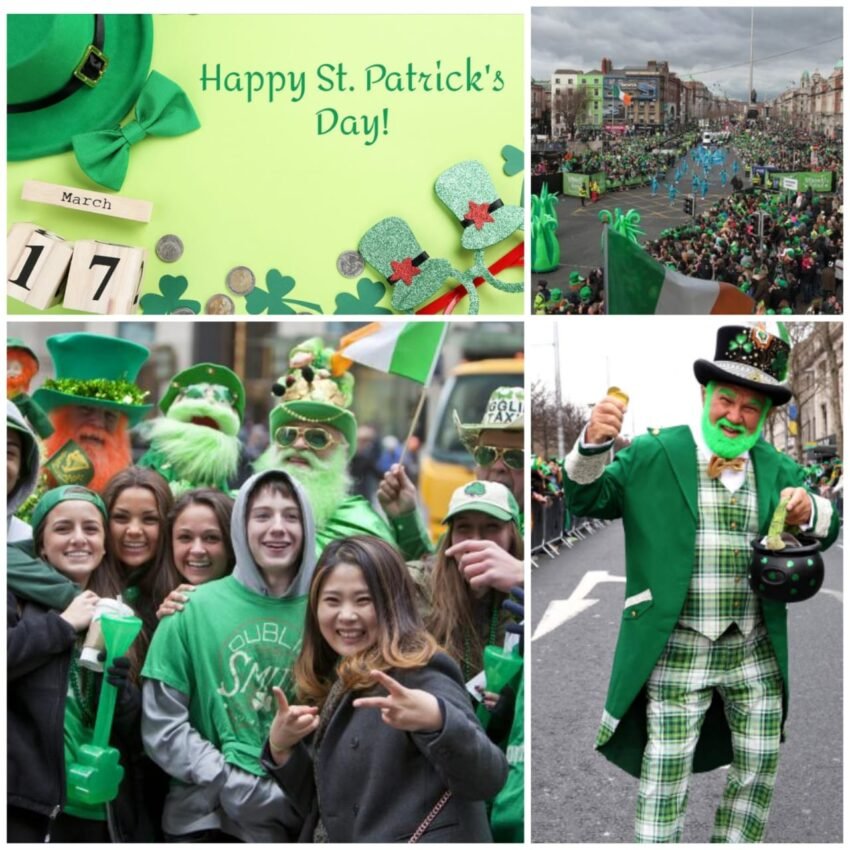The religious and cultural event known as Saint Patrick’s Day, or the Feast of Saint Patrick, is observed on March 17, the day when Saint Patrick, Ireland’s most venerated patron saint, is believed to have passed away.
The Catholic Church, the Anglican Communion (particularly the Church of Ireland), the Eastern Orthodox Church, and the Lutheran Church all celebrate Saint Patrick’s Day, which was declared a Christian feast day in the early 17th century. In addition to celebrating Saint Patrick and the introduction of Christianity to Ireland, the day also honors the Irish people’s rich cultural legacy. Typically, celebrations include céilithe, public parades and festivals, and the wearing of shamrocks or green clothing. Church services are also attended by Christians who are members of liturgical denominations. Historically, the holiday’s custom of celebration has been fostered by the lifting of the Lenten prohibitions on alcohol consumption and fasting during the day.
The Canadian province of Newfoundland and Labrador (for provincial government employees), the British Overseas Territory of Montserrat, the Republic of Ireland, and Northern Ireland all observe Saint Patrick’s Day as a public holiday. In countries like Great Britain, Canada, the United States, Australia, New Zealand, and South Africa where there is a sizable Irish diaspora, it is also often seen. More nations commemorate Saint Patrick’s Day than any other national holiday. The Irish diaspora’s festivities, especially those that evolved in North America, have had a significant impact on modern ones. Nonetheless, Saint Patrick’s Day festivities have come under fire for being too commercialized and for feeding unfavorable preconceptions about Irish people.
Saint Patrick
In the fifth century, Saint Patrick served as a Christian missionary and bishop in Ireland. The Declaration, purportedly authored by Saint Patrick himself, provides a great deal of information about him. He is said to have been born into a prosperous Romano-British family in fourth-century Roman Britain. His grandpa was a priest, and his father was a Christian deacon. He was carried as a slave to Gaelic Ireland by Irish invaders when he was sixteen, according to the Declaration. It claims that he discovered God there while serving as a shepherd for six years. According to the Declaration, God instructed Patrick to run to the coast, where a ship would be ready to transport him back to his family. Patrick eventually returned home and became a priest.
Tradition holds that Patrick went back to Ireland in order to convert the pagan Irish people to Christianity. According to the Declaration, he converted hundreds of people throughout his many years of evangelizing in Ireland’s north.
According to tradition, he passed away on March 17 and was laid to rest at Downpatrick. In the years that followed, Patrick became the most revered saint in Ireland and was the subject of numerous stories.
Celebration and traditions
The customs that evolved among the Irish diaspora, particularly in North America, have had a significant impact on modern Saint Patrick’s Day festivities. Prior to the latter part of the 20th century, Saint Patrick’s Day was frequently celebrated more widely in the diaspora than in Ireland. Typically, celebrations include wearing green clothing or shamrocks, Irish traditional music performances, and public parades and festivals. Although they were more prevalent in the past, formal events like banquets and dances are still held today. Parades celebrating Saint Patrick’s Day did not make their way to Ireland until the 20th century, having started in North America in the 18th century. The military, fire departments, marching bands, cultural organizations, nonprofits, volunteer associations, youth groups, fraternities, and so forth are typically among the participants. Nevertheless, many of the parades have evolved into carnival-like events throughout time. With Seachtain na Gaeilge (“Irish language week”) from March 1 to St. Patrick’s Day on March 17, more effort is made to speak Irish.
Tourism Ireland’s “Global Greening Initiative” or “Going Green for St Patrick’s Day” has been celebrating Saint Patrick’s Day by lighting up iconic locations in green since 2010. Since then, more than 300 monuments in 50 nations have gone green for Saint Patrick’s Day, with the Sydney Opera House and Auckland’s Sky Tower being the first to do so.
The day also sees the lifting of the Lenten prohibitions on alcohol and food, and Christians are free to attend church services. It’s possible that this is why consuming alcohol, especially Irish whiskey, beer, or cider, has become a staple of the festivities. Ireland’s stout, a dark ale beer that is a staple of the celebration and for which breweries prepare months in preparation, is a notable example of this loosening of fasting regulations.
Wearing green and shamrocks
It is traditional to wear shamrocks, green apparel, or green accessories on Saint Patrick’s Day. The three-leaved plant known as shamrock is credited by Saint Patrick with helping the pagan Irish understand the concept of the Holy Trinity. Although it could have existed earlier, this narrative was first recorded in writing in 1726. Three was a big number in ancient Ireland, and the Irish possessed a lot of triple deities, which could have helped St. Patrick in his missionary work. According to Roger Homan, “We can perhaps see St Patrick drawing upon the visual concept of the triskele when he uses the shamrock to explain the Trinity” . [37] According to Patricia Monaghan, there is no proof that the pagan Irish held the shamrock in high regard. [35] According to Jack Santino, it could have symbolized nature’s capacity for regeneration and was reinterpreted in a Christian setting. Saint Patrick is frequently seen “with a cross in one hand and a sprig of shamrocks in the other” in icons of the saint.
A narrative from the eleventh century called Lebor Gabála Érenn (The Book of the Taking of Ireland) is the first instance of the color green being associated with Ireland. The Goidelic languages (Irish, Scottish Gaelic, and Manx) were created by Goídel Glas (Goídel the green), the Gaels’ namesake ancestor. Moses applies his staff to Goídel’s deadly snakebite, saving him from death, but leaving him with a green mark. His ancestors relocate to snake-free Ireland. After ascending the Tower of Hercules and being mesmerized by the distant view of a stunning green island, one of the first, Íth, travels to Ireland.
When the Irish Catholic Confederation adopted the green harp flag in the 1640s, the color green became even more closely linked to Ireland. This flag was later referred to as “the sacred emblem of Ireland’s unconquered soul” by James Connolly. Since at least the 1680s, people have celebrated Saint Patrick’s Day by wearing shamrocks and green ribbons. The color green and its connection to St. Patrick’s Day have increased since then. Green became the official color of the Friendly Brothers of St. Patrick, an Irish brotherhood that was established in 1750. Instead, blue was chosen as the color of the organization of St. Patrick, an Anglo-Irish chivalric organization that was established in 1783. As a result, blue became linked to Saint Patrick. The United Irishmen selected the color green in the 1790s. In 1798, this republican organization, which was mostly created by Protestants but had a large Catholic membership, revolted against British control. Ireland was initially referred to as “the Emerald Isle” in William Drennan’s poem “When Erin First Rose” (1795), which emphasizes the historical significance of green to the Irish and was written by one of the co-founders of the United Irishmen. The phrase “wearing of the green” refers to a song about United Irishmen being persecuted on account of their green attire. The Irish Republic’s Proclamation Flag and the Starry Plough banner were among the green-themed banners used during the 1916 Easter Rising. The government mandated that all post boxes be painted green upon the establishment of the Irish Free State in 1922, using the catchphrase “green paint for a green people.” In 1924, the government also produced a green Irish passport.
In Ireland, it was also common to wear the “St Patrick’s Day Cross” until the early 1900s. These were paper crosses with a bunch or rosette of green silk in the center, “covered with silk or ribbon of different colors.” They were Celtic Christian crosses.
Criticism
Saint Patrick’s Day festivities have drawn criticism, especially since they are linked to disruptive behavior and public intoxication. Some contend that the celebrations have deviated from their original intent of honoring Saint Patrick and Irish history and have become overly commercialized and cheesy. Attempts to reframe Saint Patrick’s Day as a celebration of multiculturalism rather than Irishness have drawn criticism from Irish American columnist Niall O’Dowd.
Additionally, Saint Patrick’s Day festivities have come under fire for feeding dehumanizing preconceptions about Ireland and Irish people. Wearing ‘leprechaun clothes’, based on disparaging 19th-century caricatures of the Irish, is one example. The Ancient Order of Hibernians successfully fought to prevent big American stores from carrying novelty items that propagated unfavorable Irish stereotypes in the lead-up to Saint Patrick’s Day 2014.
Critics have called Saint Patrick’s Day celebrations outside of Ireland “Plastic Paddyness,” in which outsiders act out Irish clichés, claim Irish identity, and take and distort Irish culture.
Conclusion
Saint Patrick’s Day honors both Irish ancestry and religious customs. It has become an international cultural event while also commemorating Saint Patrick’s contribution to the spread of Christianity in Ireland. Parades, wearing green, and gatherings that foster camaraderie are all part of the celebration. It has been criticized, meanwhile, for commercialization and stereotype reinforcing. Saint Patrick’s Day is nevertheless a significant global celebration of Irish identity and culture in spite of this.


